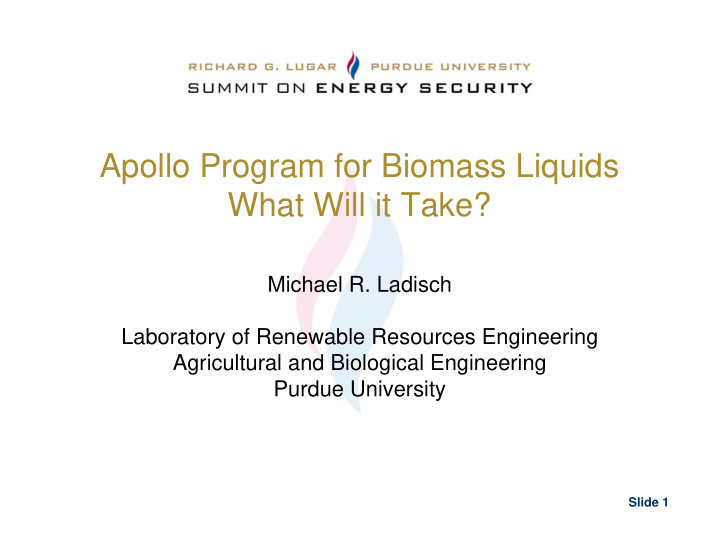



Apollo Program for Biomass Liquids What Will it Take? Michael R. Ladisch Laboratory of Renewable Resources Engineering Agricultural and Biological Engineering Purdue University Slide 1
Corn Source: Nicolle Rager Fuller, National Science Foundation Slide 2
Slide 3 Transport Harvest to Bioprocessing Supply Chain Grow Store Sun Fertilizer Water Seed
Build on Existing Infrastructure for Corn Trucking the feedstock Trips of 5 to 40 miles, one way, for corn Costs about 12 cents per bushel corn 4.6 cents per gallon ethanol $ 5 / ton (dry basis) corn 10 cents per cu. ft. corn Maier and Ileleji, 2006 Slide 4
Corn Weighs more than Corn Stover (Cellulose) translates to larger storage volumes for cellulose feedstock for a given ethanol production 3 Corn 2 gal EtOH Corn Stover / cu ft (Cellulose) 1 0 Slide 5
Slide 6 Supply Chains: Store, then Transport Harvest Store to Bioprocessing Transport Grow Sun Fertilizer Water Seed
Bioprocessing Enzymes Yeast Glucose xylose Pretreatment Hydrolysis Fermentation Fuel Ethanol Distillation Delivery to markets Infrastructure Slide 7
Projections: US Ethanol Production 2006 4.8 (corn) 2008 7.5 (corn + cellulose) 2015 12.0 (corn + more cellulose) 2030 60.0 (a lot of cellulose + corn) It will happen here Slide 8
Slide 9 Ethanol Plant Locations
Biomass Resources in Tons / sq km /year Sets stage for Cellulose Ethanol From NREL Website, 2005 Slide 10
Corn Stover: 1 to 2 tons /acre Stalks Leaves Roots Cobs
Bioethanol Production Feedstock Preparation Pretreatment Hydrolysis Ethanol of Solids Fermentation Slide 12
Pretreatment gives Cellulose enzyme accessible substrate Lignin Amorphous Pretreatment Region Crystalline Region Hemicellulose Slide 13
Components of plant cell walls Cellulose Cellulose Fermentable sugars obtained from cellulose in 1819 Lignin Lignin Extractives Extractives Hemicellulose Ash Ash (need special yeast to convert to ethanol) Chapple, 2006; Ladisch, 1979 Slide 14
Yeast Metabolism: pentose fermentation Xylose Glucose NAD(P)H NAD(P)+ Xylitol Glucose-6-P NAD+ NADH Fructose-6-P Xylulose Glyceraldehyde-3-P Xylulose-5-P NAD+ NADH 3-Phosphoglycerate PPP Ethanol NADH NAD+ Phosphoenolpyruvate Ho et al Slide 15 Pyruvate TCA Cycle Acetaldehyde
Yields of Ethanol from Corn Stover (Cellulose Ethanol) From Cellulose: 50 to 55 gal / ton From Xylan: 30 to 35 gal / ton Total: 80 to 85 gal / ton. Corresponds to about 250,000 tons /yr for 20 million gal per year plant Requires engineered yeast, pretreatment cellulase enzymes Slide 16
Other molecules from biomass sugars Fermentable sugars are the feedstock Products in addition to ethanol Butanol, Acetone 2,3 Butanediol Acetic, Lactic acid Microbial polysaccahrides (for enhanced oil recovery) Ladisch et al, 1979; 1991 Slide 17
Plant Cell Wall Genomics at Purdue Identified over 1100 genes involved in cell wall construction Generated over 900 mutants in Arabidopsis and 200 in maize; maize mutants represent a resource of genetic diversity for feedstock testing Characterized cell walls of these materials using spectroscopic, chemical, and imaging assays Identified novel cell-wall genes that can contribute to feedstock diversity Used genetics and molecular biology to analyze the functions of cell-wall gene products http://cellwall.genomics.purdue.edu *Supported by the NSF Plant Genome Research and REU Programs Slide 18
Trees: 5 to 10 tons /acre Chapple and Meilan, 2006 http://www.gvrd.bc.ca/
Slide 20 Switchgrass: 5 to 10 tons /acre, less inputs Elbersen, Wageningen, 2004
Using Hay 1 Bale = 970 lbs = 2000 miles Assuming 50 gal x 40 mpg Engel, 2006 Slide 21
Vision Learning and engagement to illustrate science and engineering as agents of change Transfer discovery from laboratory to the field or plant in a contiguous high tech / biotech / agriculture corridor Combine engineering, science and agriculture to catalyze of sustainable growth of a US bioenergy sector Work is not complete until it proven valuable to industry. Slide 22
Challenges: What will it take? Utilize biomass materials from a wide range of sources: Cellulosics Fiber Corn Apply biotechnology and nanotechnology to develop bio-catalytic conversion routes Yeasts Fixed bed catalysts Enzymes Slide 23
Opportunities Designer crops for bio-energy production Bioprocess Engineering built around advanced biocatalysts (yeasts, enzymes, fixed bed catalysts) that process designer crops High energy corn that maximizes polysaccharides rather than oil or protein Understand role of forages (switchgrass) and wood poplar grown for energy crops Seeds for the same Slide 24
Research Plant genomics Microbial genomics Bioprocess Engineering Agriculture Economics Industrial Test Beds Slide 25
Recommend
More recommend